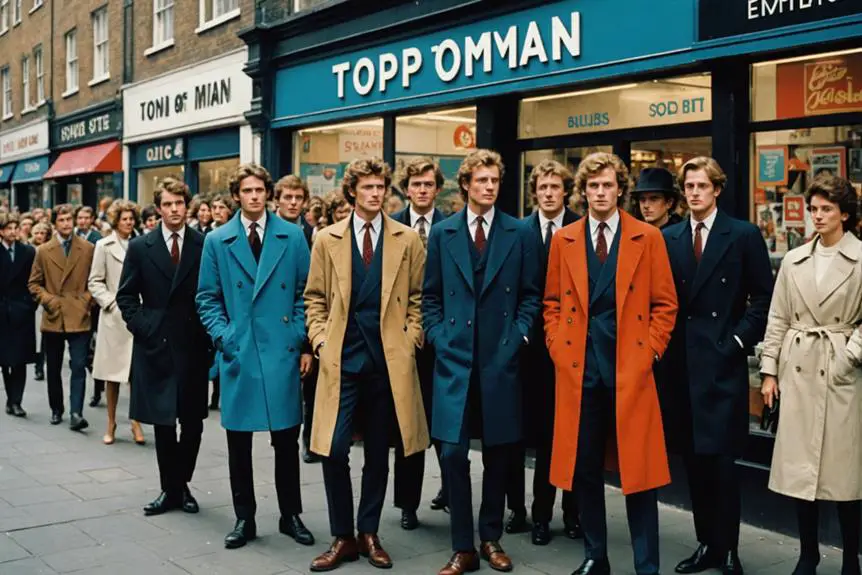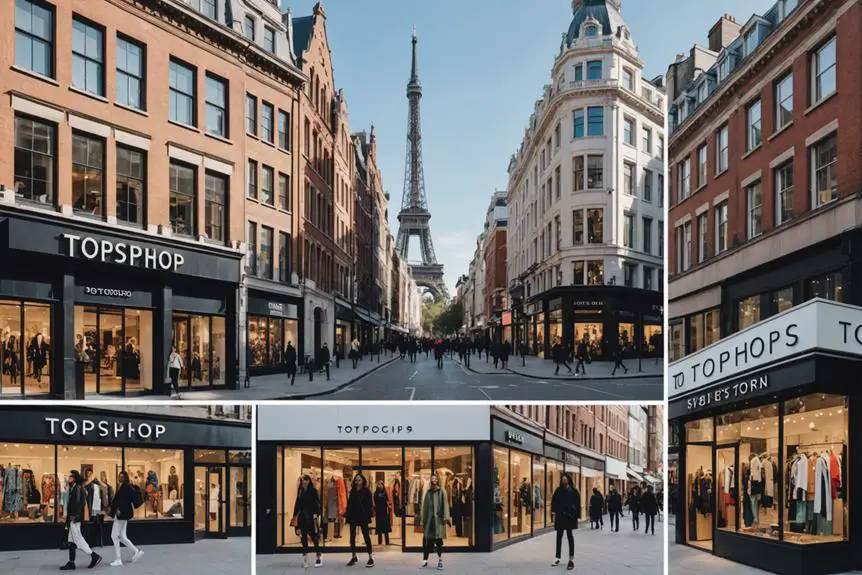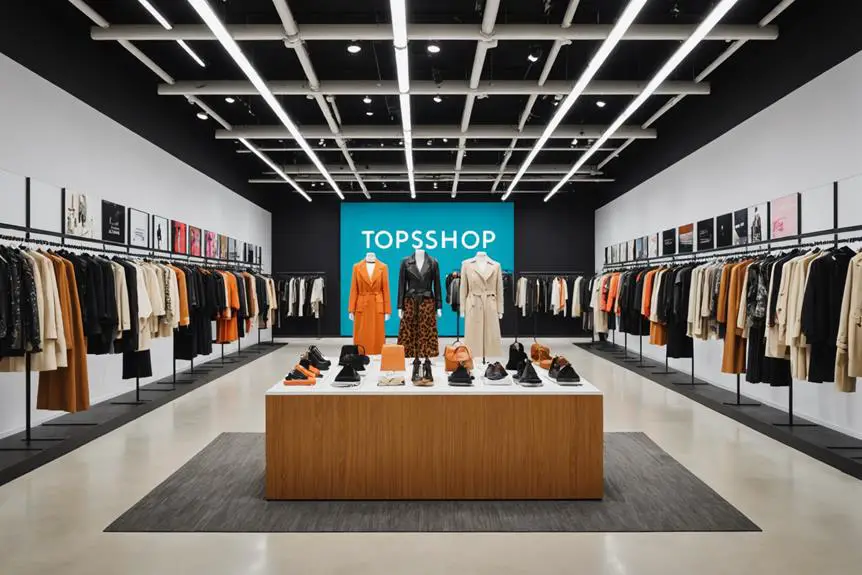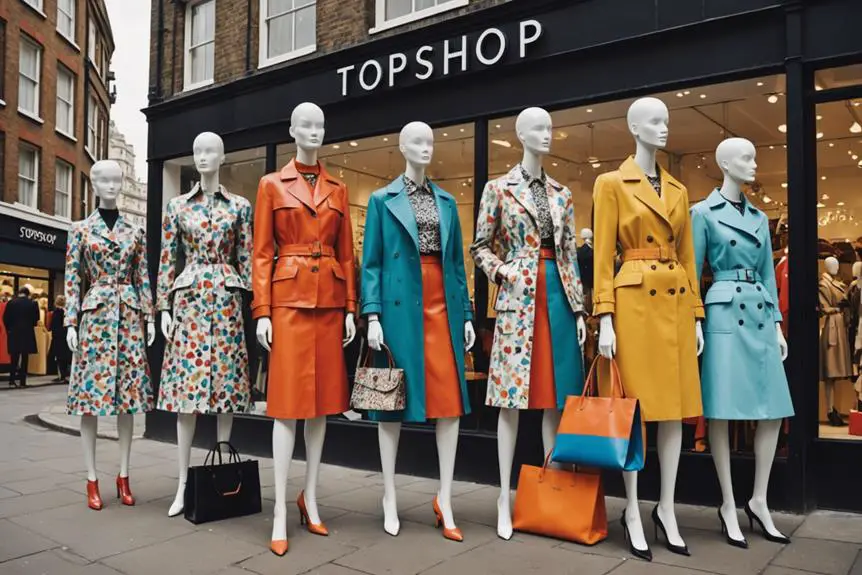Topshop's journey began in 1964 as a small section in Sheffield, encapsulating the vibrant spirit of the 1960s youth culture. By 1974, it had transformed into standalone stores, rapidly expanding and introducing Topman in 1978. The flagship store at Oxford Circus, which opened in 1994, set new standards for retail with its immersive shopping experiences and innovative designer collaborations, significantly enhancing its brand prestige. Despite encountering financial setbacks that led to ASOS's acquisition in 2021, Topshop continues to maintain its global relevance. The brand is now evolving towards online retailing and sustainability, adapting to contemporary trends. More insights await on how Topshop navigates its intricate history and future direction.
Origins in Sheffield

In the vibrant landscape of the 1960s, Topshop emerged as a revolutionary force in youth fashion, founded in 1964 by Raymond Montague Burton within the Sheffield branch of Peter Robinson. Initially, it operated as a modest section in the store's basement, targeting young women's clothing at a time when mainstream fashion largely ignored this demographic. The cultural events of 1964, particularly the rise of The Beatles, encapsulated the youthful spirit that Topshop aimed to embody, making it a beacon for the emerging youth culture. As the brand evolved, it played a pivotal role in supporting emerging designers through initiatives that showcased innovation and creativity.
By 1974, the brand's popularity surged, prompting its evolution into a standalone store. This expansion resulted in 55 locations across the UK, and within just two years of its establishment, Topshop achieved an impressive profit of £1 million. This growth not only reflected the brand's innovative approach but also the shifting dynamics in fashion consumption among youth.
In a bold move, Topshop introduced Topman in 1978, showcasing its commitment to inclusivity by venturing into menswear during a period when traditional tailoring was in decline. This strategic expansion solidified Topshop's position as a key player in shaping youth fashion in Britain.
Expansion and Standalone Store
The transformation of Topshop into a standalone store marked a significant shift in the retail landscape, reflecting both ambition and innovation. By 1974, Topshop evolved from a small section within Peter Robinson's store to a vibrant brand targeting young adults aged 13 to 25. This change proved lucrative, as by 1976, Topshop generated profits of £1 million, contributing a third of the Burton Group's profits by 1978.
The expansion was remarkable; within two years of independence, Topshop boasted 55 standalone branches. The flagship store opened in Oxford Circus in 1994, surpassing 90,000 sq ft and featuring unique amenities, like a DJ booth and nail bar, which attracted a youthful crowd.
| Year | Milestone |
|---|---|
| 1974 | Change to standalone store |
| 1976 | £1 million profits |
| 1994 | Flagship store opens in Oxford Circus |
| Mid-2000s | 510 global shops established |
Launch of Topman

Fashion enthusiasts were enthusiastic for a fresh take on menswear when Topman made its debut in 1978, responding to a burgeoning demand for stylish options tailored specifically for men. The first Topman store opened in Leeds, symbolizing a commitment to inclusive fashion that catered to all genders. This move recognized the shifting landscape of men's fashion, as traditional tailoring faced a decline, and contemporary styles began to dominate.
By showcasing its collections at London Fashion Week starting in 2005, Topman firmly established itself within the fashion industry, appealing to a younger demographic keen for modern aesthetics. The brand's approach underscored its influence in the retail market, offering versatile pieces that resonated with consumers seeking something beyond conventional menswear.
Topman's popularity highlighted the transformation in men's fashion, emphasizing a casual yet polished look that appealed to a broader audience. As retailers struggled to adapt to changing tastes, Topman emerged as a key player, championing innovative designs and accessible fashion. This commitment to contemporary styles not only marked a significant shift in men's fashion but also reinforced Topshop's legacy as a pioneer in inclusive fashion trends.
Flagship Store in Oxford Circus
One of the most iconic destinations for fashion lovers emerged with the opening of the Topshop flagship store in Oxford Circus in 1994. Spanning over 90,000 sq ft across three floors, this store quickly became one of the largest fashion retailers globally. Its location near the Oxford Circus tube station made it a prime spot for fashion-conscious shoppers seeking an unparalleled shopping experience.
The flagship store was not just about fashion; it incorporated unique amenities that transformed traditional retail. With a DJ booth, nail bar, and food stalls, Topshop curated an immersive environment for customers. Additionally, services like personal shopping and one-hour tailoring added a bespoke touch, catering to individual needs.
Here's a look at the key features of the Oxford Circus flagship:
| Feature | Description | Impact |
|---|---|---|
| Size | Over 90,000 sq ft across three floors | One of the largest globally |
| Amenities | DJ booth, nail bar, food stalls | Enhanced shopping experience |
| Services | Personal shopping, one-hour tailoring | Tailored customer engagement |
This blend of amenities and services set a new standard, positioning Topshop as a leader in the retail landscape.
Key Designer Collaborations

While many brands were still figuring out how to engage with consumers through collaborations, Topshop took a bold step into the designer partnership arena with its inaugural collaboration with Red or Dead in 1994. This initiative set a precedent for future capsule collections, capturing significant media attention and elevating the brand's profile.
In 2007, Topshop partnered with British supermodel Kate Moss, resulting in a collection that not only showcased her unique style but also enhanced Topshop's prestige within the fashion industry. Collaborations with designers like Markus Lupfer and Hussein Chalayan followed suit, leading to rapid sell-outs and increasing brand desirability among consumers keen for exclusive designs.
The limited edition range by artist Stella Vine, featuring T-shirts with eye-catching slogans, further engaged Topshop's youthful audience, reinforcing its reputation for trendy, accessible fashion. Additionally, the 2014 collaboration with Beyoncé for Ivy Park marked Topshop's significant foray into activewear, demonstrating the brand's ability to adapt to evolving fashion trends. Through these strategic partnerships, Topshop has consistently positioned itself as a key player in the dynamic landscape of designer collaborations, influencing consumer tastes and trends.
Financial Challenges and Administration
After years of market dominance, Topshop faced significant financial challenges that culminated in its administration on November 30, 2020. Owned by Arcadia Group, the brand struggled due to shifting consumer behaviors and the devastating impact of the COVID-19 pandemic. By 2020, Topshop's sales were in decline, and it lost relevance in a rapidly changing retail environment.
Following the administration, ASOS entered exclusive talks to acquire Topshop and other Arcadia brands, finalizing the deal on February 1, 2021, for £265 million, plus £65 million for stock. While the acquisition aimed to revitalize the brand, it also put approximately 2,500 jobs at risk due to planned store closures as part of a restructuring strategy. In a bid to adapt, Topshop shifted its focus toward online retailing, closing numerous physical stores, including those in the U.S.
Despite the initial success of Topshop, which generated profits of £1 million in 1976, the brand's journey reflects a stark reality—market dominance does not guarantee longevity, especially amidst financial challenges and changing consumer landscapes.
Global Operations and Market Presence

Topshop's global operations and market presence illustrate the brand's ambitious journey to capture a diverse customer base across various regions. With around 510 shops globally, over 300 of which are UK stores, Topshop has established a strong domestic foundation. The international expansion began in the mid-2000s, characterized by flagship stores in New York City, including the monumental Fifth Avenue location.
| Year | Key Event | Impact |
|---|---|---|
| 2009 | Opened flagship store in NYC | Enhanced US market presence |
| 2011 | Launched in Australia | Initial international growth |
| 2017 | Entered voluntary administration | Highlighted operational challenges |
| 2021 | ASOS acquisition | Shifted focus to online fashion |
| 2020 | Closed last Australian store | Reflective of retail closures |
Following ASOS's acquisition in February 2021, Topshop faced retail closures in Israel, the Philippines, and parts of the Middle East. The brand adapted to the shifting consumer behavior towards e-commerce, enhancing its online operations to maintain relevance in the competitive online fashion landscape. This shift underscores the need for resilience in market presence amid changing dynamics.
Ethical Concerns and Controversies
The fashion industry often grapples with ethical concerns, and Topshop has been no stranger to controversy. In 2010, protests erupted outside its branches over accusations of tax avoidance, sparking a public outcry that questioned the brand's commitment to corporate responsibility. Ethical sourcing became a significant issue when allegations surfaced that Topshop used cotton sourced from forced labor in Uzbekistan, further alienating conscious consumers.
The brand's troubles didn't stop there. In 2013, Topshop faced a lawsuit from Rihanna for unauthorized use of her image, tarnishing its public image further. In 2015, protests against the use of skinny mannequins highlighted body image concerns, prompting Topshop to cease their use in an effort to promote healthier standards.
In 2016, the United Voices of the World (UVW) union led protests demanding living wages and improved treatment for outsourced cleaners, shining a light on ongoing labor rights issues within the company. These controversies have not only damaged Topshop's reputation but also raised critical questions about the ethics of fast fashion and the responsibility brands hold towards their workers and consumers.
Future Prospects and Industry Impact

Frequently facing challenges and opportunities in a rapidly evolving fashion landscape, Topshop is strategically positioning itself for a comeback. Following its acquisition by ASOS, the brand aims to revitalize its online presence and explore re-entry into previously abandoned markets. With Nordstrom's minority stake, Topshop targets a younger demographic, enhancing its brand presence in the U.S. through exclusive channels.
The shift towards e-commerce has highlighted the necessity for digital investment, allowing Topshop to adapt to changing consumer behavior and compete effectively against fast-fashion rivals.
| Strategy | Focus Area | Expected Outcome |
|---|---|---|
| E-commerce Expansion | Online Retail | Increased accessibility |
| Sustainability | Ethical Sourcing | Improved brand reputation |
| Innovative Marketing | Consumer Engagement | Enhanced shopping experience |
Sustainability and ethical sourcing are becoming essential as consumer demand for responsible fashion grows. By committing to these principles, Topshop not only aligns with modern values but also sets a precedent in the fashion industry. As it navigates these waters, Topshop's legacy of innovative marketing can serve as a guiding force, reinforcing its position as a leading fashion retailer.
Frequently Asked Questions
What Happened With Topshop?
You'll find that Topshop faced significant challenges after entering administration in 2020. ASOS acquired the brand, shifting its focus to online retail, while store closures and job losses marked a dramatic change in its operation.
What Did Topshop Used to Be Called?
Topshop used to be called "Peter Robinson's Top Shop." This name reflected its origins as a section in a department store before it evolved into a standalone brand, ultimately becoming a fashion staple for young adults.
What Company Owned Topshop?
Topshop was owned by the Arcadia Group, led by Sir Philip Green. This ownership considerably influenced its market strategy and growth until the group entered administration, prompting its sale to ASOS in early 2021.
What Is the History of Topshop Oxford Street?
You'll find Topshop Oxford Street's history fascinating, showcasing its 1994 opening as a fashion hub. It thrived with innovative features, but ultimately faced challenges, leading to its closure in 2020. It shaped youth fashion greatly.





Howdy! This is kind of off topic but I need some help from an established blog. Is it difficult to set up your own blog? I’m not very techincal but I can figure things out pretty quick. I’m thinking about creating my own but I’m not sure where to start. Do you have any points or suggestions? Thank you
??????? ??? ?????? ? ?????? ????????? ???????? [url=http://www.kredit-bez-otkaza-1.ru]??????? ??? ?????? ? ?????? ????????? ????????[/url] .
??????? ???????? [url=http://psihiatry-nn-1.ru]??????? ????????[/url] .
https://t.me/s/Webs_1WIN
https://t.me/s/TeleCasino_1Win